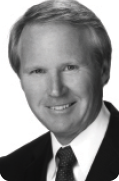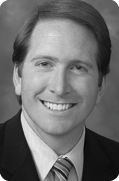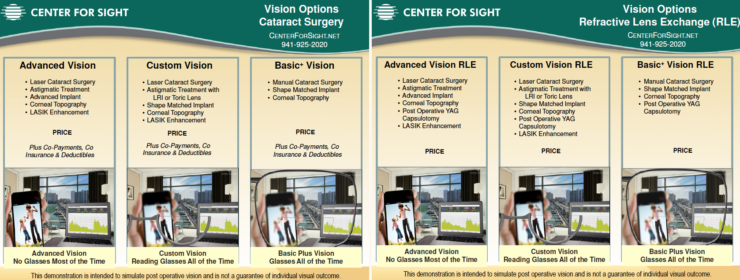
Mark Kontos, MD
With so much technology available, educating patients about their options has become a significant part of the cataract consultation. In our office, my colleagues, staff, and I are continually refining how we inform patients about the cataract procedure and current technology.
AN EARLY START
Because optometrists refer 50% of our patients, they often have already received some education on the surgical process and the lenses available to them. In some cases, patients have decided what they want, whether it is monovision or undergoing microinvasive glaucoma surgery at the time of the cataract procedure. About half, however, do not have a detailed understanding of cataract surgery or the options available to them.
Our educational process begins before patients arrive for their consultation. When they make their appointment, they are directed to the practice’s website, where they can fill out paperwork and learn about our surgeons as well as their cataracts and how we treat them. Videos show the benefits of surgery and some testimonials from previous patients describing their experiences.
AT THE CLINIC
Once patients arrive for their consultation, they receive some general information during the exam from the ophthalmic technicians performing the workup. While patients wait to see the surgeon, they watch a short video we produced. It features our surgeons describing the surgical process in detail. The video also provides a virtual tour of our surgical facility and introduces patients to the people they will encounter during their procedure. In addition, the video addresses laser cataract surgery, new lens technology, and the associated risks.
THE SURGEON
The most fundamental aspect of patients’ education remains their discussion with the surgeon. All other parts of the process are meant to facilitate that event. The nuances of laser cataract surgery and new IOLs make this discussion critical. Some patients may simply instruct the surgeon, “Do what you think is best for me.” Others desire much more complex discussion that requires more than one visit.
CONCLUSION
Our practice uses all the tools it can to help cataract patients have the best experience possible. Videos, social media, online reviews, testimonials, and counselors all enhance patients’ experiences. They continue to receive most of their information and have their questions answered, however, as they always have in our office: through conversation with the surgeon.

William J. Lahners, MD
One of the most amazing things about practicing ophthalmology is the technology that physicians can offer to patients to enhance their surgical experience, their vision, and ultimately their lives. Being able to offer patients laser cataract surgery with presbyopia-correcting implants is incredible. These technologies and many others have enhanced my ability to deliver the best outcomes and independence from glasses. Unless surgeons can adequately explain these options to patients and properly educate them, however, they may not understand their choices or the merits of each. We employ a variety of technologies at Center for Sight to educate and counsel patients.
EMPATHY
We believe in providing the most personal and compassionate care possible. Although various technologies improve our ability to convey information, we have found that there is no substitute for a properly trained, empathic human specialist. We dedicate a tremendous amount of energy to recruiting professional individuals whom we train in-house to educate and guide patients on what is going to be a lifelong decision. We call these professionals “PCCs,” meaning patient care counselors. They meet with patients during the presurgical visit and provide them with visual aids as well as a thorough review of the options for which their surgeon has approved them.
The PCCs are experts on the nuanced differences between the Tecnis Multifocal and the Tecnis Symfony IOLs (Abbott). They also discuss pricing and financing options. Because many of our PCCs have undergone surgery at our practice and are personal advocates of the technology we offer, they represent a powerful and personal way for patients to connect with these options.
VISUAL LEARNING
The PCCs provide each patient with an educational and personal review of ocular anatomy and cataract surgery options. They use a small eye model to demonstrate what happens during surgery in simple terms. Historically, we have also used videos from Rendia (formerly Eyemaginations), which have been very helpful as well.

Figure. A 1-page simulation of postoperative vision shown to patients at Center for Sight. Actual prices are used but have been redacted for publication.
In addition, we lay out the three different choices for cataract surgery on 1 page (Figure). Below the description, we show a simulation of patients’ vision after receiving each option. For example, with the advanced technology package, we expect that most patients will be able to see at distance and near without glasses. Simple images explain the relative merits of each package without getting too technical.
Further explanation by both the surgeon and the PCC is based on a patient’s needs. For example, among patients interested in our advanced technology package, we are more likely to discuss multifocal options with a 75-year-old reader of paperback novels and the Tecnis Symfony IOL with a 59-year-old pilot.
TAKE-HOME POINTS
We have found great value in the well-produced, high-quality brochures that Patient Education Concepts has created for each of our surgical offerings such as laser cataract surgery and all-laser LASIK. These booklets are a resource of information and reflect the quality of our practice. They typically include endorsements from celebrity patients and lifestyle considerations. In the back, the brochures generally feature a biographical sketch of the surgeon whom the patient saw or is scheduled to see. Brochures allow patients to review their options at a later time and at their own pace.
CONCLUSION
In my experience, the better we educate patients, the more likely they are to find their needs met by their surgery, be happy with their result, and become advocates for our practice. The combination of skilled and compassionate PCCs, visual demonstrations, and printed reference booklets has worked extremely well for our practice.

Vance Thompson, MD
If I were going to answer the question “What kind of patient education do you like?” in one word, it would be complete. Many patients learn things ahead of time through Internet searches and the materials our practice sends to them. It is our job to supplement their preconsultation work with an educational process that fully prepares them to make a decision about their vision. I believe that educating patients is the most significant part of their experience. Frankly, the technologies, their capabilities, and how to pay for them are becoming more complex, not simpler. Taking the time to demystify technologies and payment options for patients maximizes the chance that they will make a sound decision about their vision and not become surprised or frustrated because they misunderstood what a technology would or would not do or were mistaken about the ultimate financial commitment.
Patients want to know how much I care before they learn how much I know. Providing quality education accomplishes both goals, especially when it is delivered in a simple, accessible way with compassion, patience, eye contact, and a positive attitude. I am convinced that achieving excellence demands enjoying the process to reach that goal. I enjoy educating patients as much as any other aspect of being a physician. Handled properly, education lessens patients’ anxiety and builds their confidence in me, which I find rewarding and motivational.
THE PERSONAL TOUCH
No educational tool is better than the doctor’s personal involvement in the process. Nothing can replace the human touch of the person to whom patients will entrust their vision. Our practice’s emphasis on personal care extends from the surgeon to the optometrist and staff.
Our practice uses many educational tools and approaches, but direct, one-on-one communication has the greatest impact by far. Along these lines, we still find value in the use of an eye model.
PRINT MATERIALS
Informational brochures continue to play an important role in our practice. Many of these materials we developed ourselves, but we have used companies such as Patient Education Concepts to supplement our work with great success. Their patient education and informed consent videos are very good as well.
STYLES OF COMMUNICATION
Changing demographics demand refinement and innovation of our educational approach. In recent years, our practice has been in the vanguard of developing new styles of communication with Rendia (formerly Eyemaginations). We find the company’s high-impact digital media to be well produced and easily understood by our patients. The utility of these offerings extends beyond the exam room to visuals for the waiting room and materials that patients can view at home. Engaging clinical artwork and interactive digital technology have really helped our staff and doctors to connect with patients and empower them to make informed decisions about their care. In our experience, quality digital technology can simplify complex topics.
We can play videos in our waiting room, share them on our website and via social media, and email them to patients before and after their visit. Patients and referring doctors appreciate our ability to deliver video content anywhere.

Figure. Vance Thompson Vision and Matt Jensen Marketing (MJM) created this guide to answer cataract patients’ questions on premium technologies.
CUSTOMIZATION
When our practice needs something customized, we have close ties to a boutique marketing firm, MJM, which creates materials and messaging related to new technologies. Because this team is onsite, their communications are extremely focused and can be altered in real time for maximum impact. For example, alongside this team, our practice created a simple step-by-step guide to answer the salient questions that drive a cataract patient’s decision-making process. Do they want to use glasses a lot after surgery, or would they prefer much more independence from spectacles? We have found that simple educational materials can greatly assist patients and can increase their adoption of premium technologies, because patients are better equipped to participate in decisions (Figure). This outline simplifies the entire refractive cataract conversation by drawing patients’ attention to how they would like to use their vision after surgery. We hold no conversations about aberrometry or how fast a femtosecond laser is; we only discuss lifestyle. Customized messages like this one are difficult to create but are worth the fuss.
MJM’s great relationships with the other companies our practice works with help us to create a completely integrated educational process. In addition, MJM assists us with measuring the impact of our educational efforts by tracking real-time statistics with a dedicated dashboard. We can identify what resonates with our patients and make adjustments for maximum effectiveness.
CONCLUSION
Nothing is more important in our practice than our people—our team and our patients. A quality educational process benefits patients and creates a healthy practice atmosphere that is ready to thrive in the fast-paced modern world of health care.




